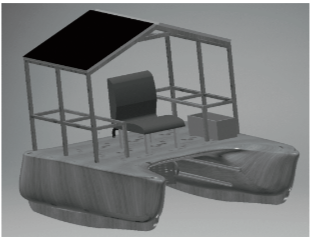Process of design an eco-friendly catamaran to extract aquatic plants
DOI:
https://doi.org/10.25043/19098642.189Keywords:
Design, catamaran, eco-friendly, spiral boat design methodologyAbstract
This paper presents the design of an eco-friendly catamaran that follows two design methodologies, one focusing in the importance in the needs of future users and the other the spiral boat design methodology. The project is going to take advantage of the unique form of a catamaran and use the space available between the points of flotation for the process of extracting small plants and light plastics from the surface of recreational lakes. With the project the esthetics and also the aquatic ecosystem of the lake would be better preserved. The application of the project, could improve the time required to recollect the duckweed and only required one operator; however, the potential of the project is significantly bigger as it could be used as a method to extract superficial contaminants in ‘garbage patches’ in the ocean and lakes without harming the species that still are in the zone of operation. Good practices of engineering are going to be use for the design of the catamaran, as well as for the selection of the necessary components.
Downloads
References
LARS LARSON, ROLF ELLISON. "Yacht Design" London, 2000.
ROBERT STEWARD. "Boat Building Manual" USA, 2014.
DANIEL CAO CHIEW. "Diseño y cálculo de una embarcación sin licencia de 5 m de eslora" España 2016.
ANTONIO GALLARDO MARTÍNEZ. "Programación de las normas ISO 12217-1 (2011) e ISO 12217-3 (2011) para el estudio de la estabilidad y flotabilidad de embarcaciones de recreo" España, 2013.
GONZÁLEZ, HARRY. "Estabilidad estática transversal", 2011.
PABLO SÁNCHEZ RODRÍGUEZ. "Diseño de una embarcación de 7 metros de Loa" España, 2013.
BUSTO RODRÍGUEZ, MANUEL RAMÓN. "Diseño de proceso de fabricación de un catamarán de fibra de vidrio en astillero", México, 2008.
YEBRA FOLGUERAL, FRANCISCO DANIEL. "Diseño y cálculo de una embarcación sin licencia de 5 m de eslora".
SOUMYA, CHAKRABORTY. "Naval Architecture", USA, 2017.
"Reglamento nacional para la asignación de francobordo para embarcaciones".
GARAYSALAZAR,ROLAND"Instalaciones Solares Fotovoltaicas, Aplicaciones en baja potencia.". Perú.
MENESES ROQUE, PEDRO ANATAEL. "Construcción y reconocimiento de embarcaciones de recreo", España, 1995.
G. VAN OORTMERSSEN. "A power prediction method and its application to small ships".
ARROYAVE, MARÍA DEL PILAR "La lenteja de agua: una planta acuática promisoria" Colombia, 2004.
ULRICH, KARL T. "Product Design and Development" 2012.
TORRALBO GAVILÁN, JORDI "Análisis y propuesta de mejora de la seguridad en las embarcaciones de recreo a través de los datos obtenidos en sus reconocimientos e inspecciones" España, 2015.
STUART, WILLIAM JOSEPH "Composite Materials Layup Lab" Usa.
S. Charca, M. E. F., R. L., S. C., "Caracterización mecánica de las fibras tecnicas Ichu y Cbuya" Departamento de Ingeniería Mecánica Y Departamento de Ingeniería Química, Universidad de Ingeniería y Tecnología, Lima, 2017.
DANISMAN, DEVRIM. "A Practical Power Prediction of an Asymmetric Catamara n Hull Form", 2005.

Published
How to Cite
Issue
Section
License
The authors who publish in this Journal certify that:
- The work submitted for publication in The Ship Science and Technology journal, was written by the author, given that its content is the product of his/her direct intellectual contribution.
- All data and references to material already published are duly identified with their respective credits and are included in the bibliographic notes and quotations highlighted as such.
- All materials submitted for publication are completely free of copyrights; consequently, the author accepts responsibility for any lawsuit or claim related with Intellectual Property Rights thereof, Exonerating of responsibility to The Science and Technology for the Development of Naval, Maritime, and Riverine Industry Corporation, COTECMAR.
- In the event that the article is chosen for publication by The Ship Science and Technology journal, the author state that he/she totally transfers reproduction rights of such to The Science and Technology for the Development of Naval, Maritime, and Riverine Industry Corporation, COTECMAR.
- The authors retain the copyright and transfer to COTECMAR the right of publication and reproduction of the work which will be simultaneously subject to the Creative Commons Attribution License (CC -BY) , which allows the license to copy, distribute, display and represent the work and to make derivative works as long as it recognizes and cites the work in the manner specified by the author or licensor.
- For more information about the Creative Commons Attribution License (CC -BY) and his use and scope, please visit the following web page https://creativecommons.org/licenses/by-sa/4.0/legalcode








